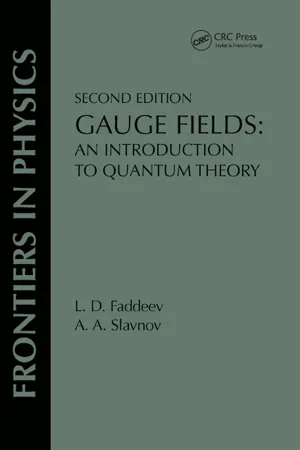
This is a test
- 236 pages
- English
- ePUB (mobile friendly)
- Available on iOS & Android
eBook - ePub
Book details
Book preview
Table of contents
Citations
About This Book
Gauge field theory describes the physics of elementary particles adequately at moderate energies. Besides, the methods applied in the field theory of relativistic strings represent a direct generalization of the methods of gauge field theory, to which this book is devoted. For this reason the author considers a new edition of it to be useful, both for direct applications of the already developed gauge theory and for search of new ways.
Frequently asked questions
At the moment all of our mobile-responsive ePub books are available to download via the app. Most of our PDFs are also available to download and we're working on making the final remaining ones downloadable now. Learn more here.
Both plans give you full access to the library and all of Perlego’s features. The only differences are the price and subscription period: With the annual plan you’ll save around 30% compared to 12 months on the monthly plan.
We are an online textbook subscription service, where you can get access to an entire online library for less than the price of a single book per month. With over 1 million books across 1000+ topics, we’ve got you covered! Learn more here.
Look out for the read-aloud symbol on your next book to see if you can listen to it. The read-aloud tool reads text aloud for you, highlighting the text as it is being read. You can pause it, speed it up and slow it down. Learn more here.
Yes, you can access Gauge Fields by L. D. Faddeev in PDF and/or ePUB format, as well as other popular books in Physical Sciences & Physics. We have over one million books available in our catalogue for you to explore.
1
Introduction:
Fundamentals of Classical Gauge Field Theory
Fundamentals of Classical Gauge Field Theory
1.1 Basic Concepts and Notation
The theory of gauge fields at present represents the widely accepted theoretical basis of elementary particle physics. Indeed, the most elaborate model of field theory, quantum electrodynamics, is a particular case of the gauge theory. Further, models of weak interactions have acquired an elegant and self-consistent formulation in the framework of gauge theories. The phenomenological four-fermion interaction has been replaced by the interaction with an intermediate vector particle, the quantum of the Yang-Mills field. Existing experimental data along with the requirement of gauge invariance led to the prediction of weak neutral currents and of new quantum numbers for hadrons.
Phenomenological quark models of strong interactions also have their most natural foundation in the framwork of a gauge theory known as quantum chromodynamics. This theory provides a unique possibility of describing, in the framework of quantum field theory, the phenomenon of asymptotic freedom. This theory also affords hopes of explaining quark confinement, although this question is not quite clear.
Finally, the extension of the gauge principle may lead to the gravitational interaction also being placed in the general scheme of Yang-Mills fields.
So the possibility arises of explaining, on the basis of one principle, all the hierarchy of interactions existing in nature. The term unified field theory, discredited sometime ago, now acquires a new reality in the framework of gauge field theories. In the formation of this picture a number of scientists took part. Let us mention some of the key dates.
In 1953 C. N. Yang and R. L. Mills, for the first time, generalized the principle of gauge invariance of the interaction of electric charges to the case of interacting isospins....
Table of contents
- Cover
- Title Page
- Half Title
- Copyright Page
- Table of Contents
- Preface to the Second Revised (Russian) Edition
- Preface to the Original (Russian) Edition
- 1 Introduction: Fundamentals of Classical Gauge Field Theory
- 2 Quantum Theory in Terms of Path Integrals
- 3 Quantization of the Yang-Mills Field
- 4 Renormalization of Gauge Theories
- 5 Some Applications and Conclusion
- Bibliography Notes
- Supplement in Proof: Anomalous Commutator of The Gauss Law
- References
- Notation